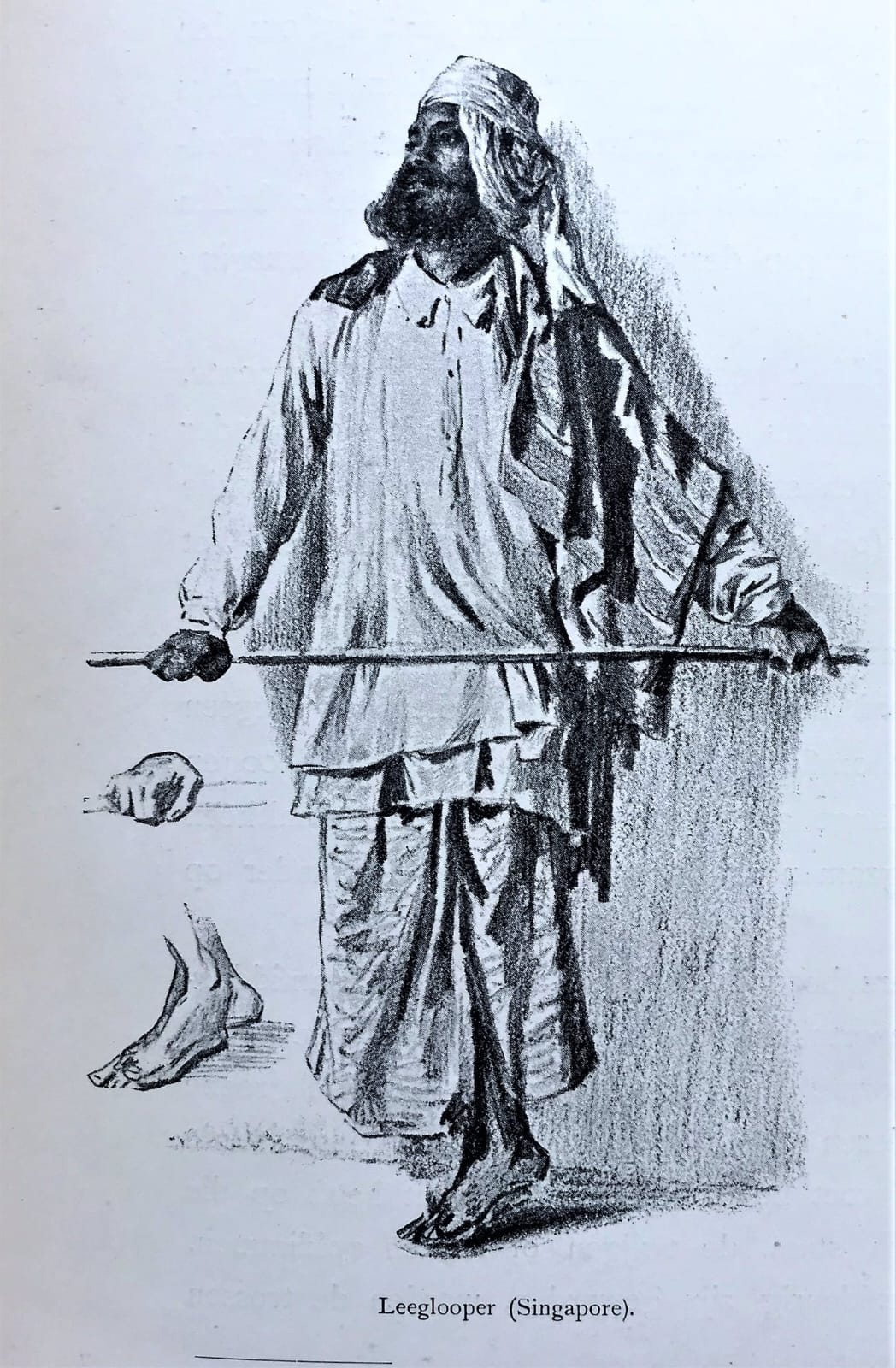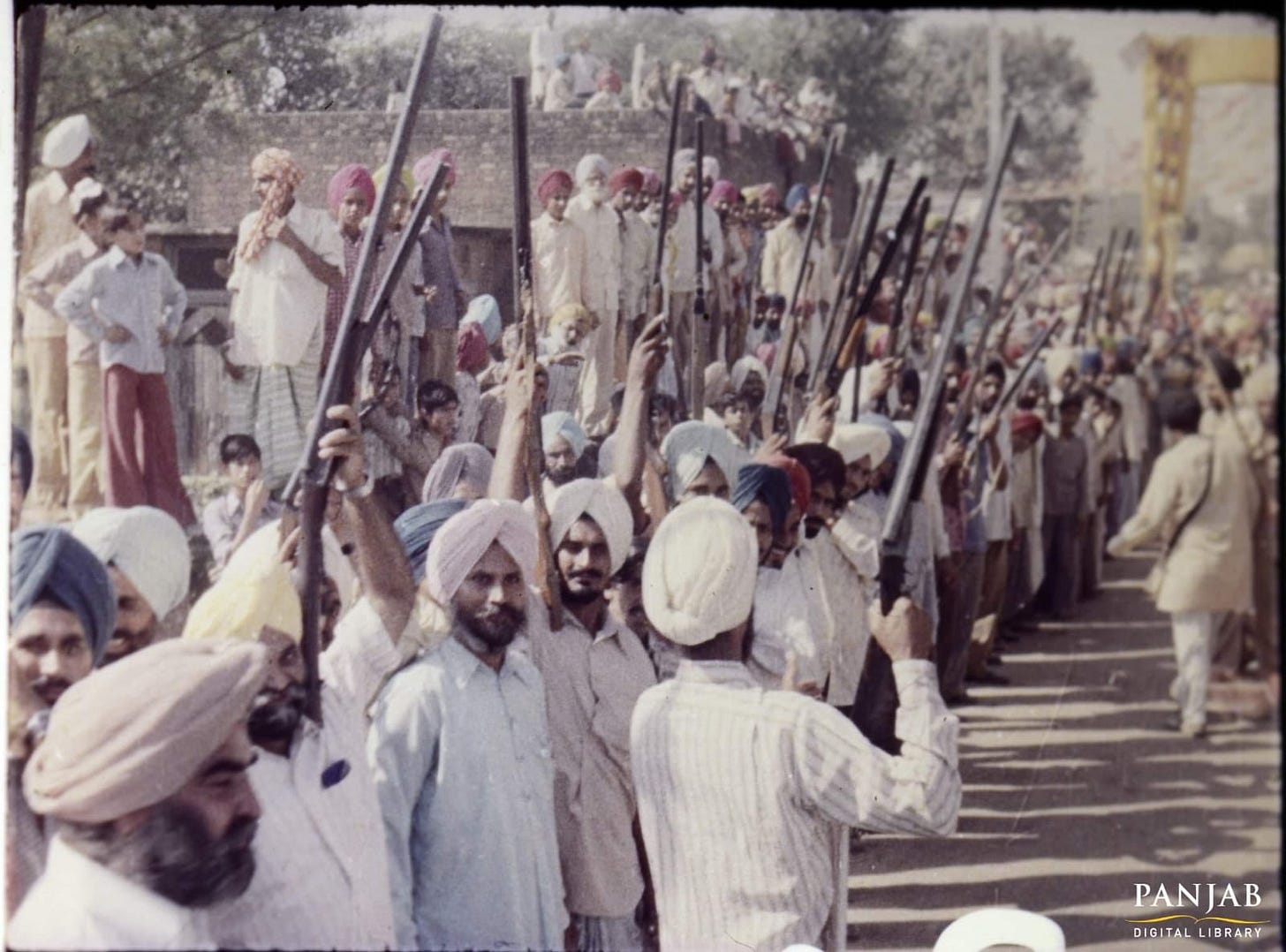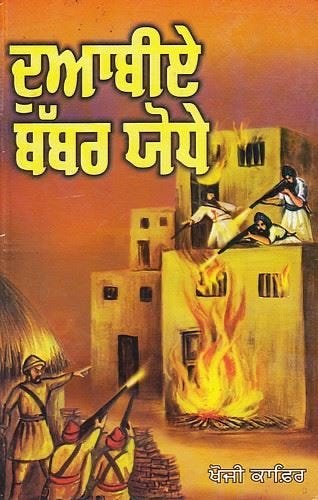The Lives of Arjan Vailly
An overview of the legend of Arjan Singh Vailly, a folk hero who inspired many popular songs and poems in the Malwa area of Punjab.
The full-blooded, bellicose, violent but chivalric rebel is a much-romanticized figure in Punjab folklore. The popularity of the song ‘Arjan Vailly,’ sung by Bhupinder Babbal, has brought this archetype back into popular discourse. Articles quickly (and erroneously) identified ‘Arjan’ as the son of Hari Singh Nalwa. A few days later, a journalist posted a more reliable account online.
Arjan Singh was born into a wealthy Virk household in Rurka village of Ludhiana. He is remembered as a strapping young man standing over six and half feet. He quickly developed a reputation for brawling, earning the moniker ‘vailly,’ reserved for men eager to fight and irreverent towards the law. He would often walk around with a long stick or a gandasa, preceding the axe-wielding Maula Jatt of Ahmed Nadeem Qasmi’s ‘Gandasa’ by a few decades.

He came to be known as a ‘vailly’ after thrashing a policeman and breaking his arm for harassing a poor man. Surinder Shinda’s song ‘Putt Jattan De’ references a fight that took place at Jagraon’s Roshni fair, when Arjan along with his friends Modan Konkya and Munshi Dango, confronted some young men from Pandori. These men showed up and threw a challenge to the crowd: was anyone man enough to fight them? This was common during fairs (AA Randhawa’s ‘Zoravar’ opens with one such scenario): in the ancient Aryan warrior’s world, notes Heesterman, conflict was the operating principle, creating order and hierarchy through violence. “It is an intensely personal order depending, as it does, on the uncertain outcome of the ever-recurring sacrificial hour of death.”
The vigorous impulse of showmanship, competition, the spirit of agonism, stirred Arjan Vailly to action. The fight quickly escalated, as these things often do, into a bloody clash with the whole of the Pandori village. Over the decades, the legendary clash was immortalized endlessly in song and verse. Shinda’s song conjures vivid images of berserk young men wearing chadras, armed with sticks and axes. Arjan splits heads open with his gandasa, and Shinda assures the listener that it was only the police’s arrival that stopped Arjan from singlehandedly turning the scene into a bloodbath.
— — -
During the Partition violence of 1947, Arjan assisted many Muslims, suddenly left homeless and vulnerable to the Partition’s violence, in moving to the district of Malerkotla. One of them was his friend Ralla Teli, whose gold and silver he safeguarded until he was able to hand them over to Teli’s son.
Later, Arjan Singh became an amritdhari Sikh, baptized into the Guru’s militant brotherhood of the Khalsa. The ferocious fire that had always boiled under his skin was now tempered by the Guru’s steel. Reinvigorated, he wholeheartedly joined the Punjabi Suba Morcha, and was imprisoned as an agitator. He was later honored by the Punjab government for his steadfast service to the movement. He was known for his philanthropy, working tirelessly to uplift the general populace of his village. He would give away sweets and candies to children who recited gurbani shabads. Gradually, the passage of time had transfigured the volatile, hot-blooded Arjan Vailly into Arjan Baba, the village’s saintlike elder.
He passed away at Rajindra Hospital in 1968. Advised to rest after a surgery, he stubbornly walked out, tearing his stitches open, bleeding to death. A ruinous, luxuriant expenditure of blood: in fight or in self-annihilating irrationality, he went out as the archetypal Punjab rebel always does.
— — -
Professor Sukhdev Singh Sirsa, on the other hand, insists there was another, older legend of ArjanVailly in the Malwa region. The boli sings of a swashbuckling outlaw who belonged to a Sidhu household in the village Daudar. Arjan Singh had five brothers: Bachan, Jagir, Malkit, Tara, Harbans. They were all fair, tall men with pale eyes and a quiet demeanor.

Most youth who turned to dacoity were usually compelled by rivalries or police harassment. Arjan, however, became an outlaw after his elder brother Bachan was shot dead by shareeks (relatives one has a blood feud with, usually over land or property; lit. ‘kinsmen,’ ‘partakers, shareholders’) during a wedding. After Bachan's murder, it is said their mother did not eat anything for a year. She refused to consume so much as a pinch of salt until Bachan’s death was avenged, until his brothers brought his murderers’ heads home.
Already troubled by local feuds, Arjan left home consumed by a thirst for vengeance. Six boys accompanied him: the vicious Roop (who later died alongside Arjan), Pala Battaa, two Ravidasias Ganga Singh and Najar, Buddh Singh, who was Majhbi, Nooruddin, a Muslim, and Bhag Singh. While the gang was on the run, Jagir Singh stayed behind, avenging his brother by killing twenty men, turn by turn, who had supported Bachan’s killers. Arjan’s run of robberies soon brought the police’s marauding presence to his home, setting up numerous checkpoints around the village.
Arjan and his gang moved in the same circles as the dreaded Babbar Akalis. Until Arjan allied with them, the Babbar Akalis had not had any contact with dacoits. Kunda Singh Babbar and Arjan worked together to assassinate S.G.M. Beatty on May 27, 1940. Beatty, as Assistant Superintendent of Police, had administered exceptionally sadistic brutalities upon the participants of the Guru ka Bagh morcha; the protestors’ resilience had stirred the sympathy of Reverend CF Andrews. (Kunda Singh himself had acquired a heroic reputation, sacking cow slaughterhouses and killing the butchers, and then killing Muslim noblemen who had coerced a poor Sikh carpenter to marry his daughters off to their sons.)
In either 1942 or ’43, Arjan was killed (Sirsa uses the term ‘shaheed’) during a shootout with the police in the dunes of Jagraon’s dusty tracts.
— — -
The site of Arjan’s fabled confrontation, the Roshni fair in Jagraon, was held in honor the Sufi dervish Mohkumdeen. Such fairs were (and remain) common, integral to Punjabi folk cosmology. Sufi pirs, folk deities, Hindu mystics and Sikh saints alike are worshipped and propitiated, in person or in spirit, through a variety of rituals, bound by common aesthetic motifs. The devotees may enjoy the performance of songs, wrestling and kabaddi bouts, joyrides and snacks. Jeona Maurh’s tale found its climatic height during his visit to the Naina Devi temple, where the goddess is said to have miraculously communicated with him.
Sirsa notes that Punjabi folk tradition come to absorb and own these singular, extraordinarily driven rebels, once their legend transcends their villages or localities. Within this ever-expanding lineage of heroes, he lists Dulla Bhatti, Arjan Velly, Jeona Maurh, Jagga Jatt, even Bhagat Singh. The prevalence of bandits, rebels, and violent strongmen among Punjab’s pantheon of folk heroes can be attributed to the brutish, hard-knocks life that Punjab’s sweltering heat and history of relentless turbulence fostered. It is commonly understood that Punjab’s position at the frontier of the subcontinent meant that it bore the brunt of invasions, while also functioning as a fertile creative seat for religious, literary and cultural syncretism.
What was forged in this furnace was a mystical, belligerent temperament, at once cruel and tender, sentimental and ruthless, laconic and excessive, a moralist and nihilist. The state and its laws meant little in a place that saw regularly kingdoms rise and fall, ensuring the unceasing routine of chaos. Dumézil remarks on Indra’s disregard or defiance as yathavasam, “according to his own will”: the law unto himself, he is alone and he is free.
Many of the fabled dacoits came from poor households, and were forced to act against the petty tyrannies of lesser men in positions of power. Folksongs always emphasize their morality: they were remembered for never harassing women, always helping the needy, always reacting swiftly against tyrants.
The heroic gesture, inevitably aggrandized, romanticized, mythicized, consecrated as an enduring image infused with rasas, inscribed over time with a glut of deeply meaningful and potent signs. In other words, turned into archetypes. To Sirsa’s list we can add the Babbar Akalis, the Ghadarites, Sant Bhindranwale, kharku youth, and now, Deep Sidhu, Sidhu Moosewala. At the same time, it is prudent to note that Punjab also has a long tradition of struggles rooted in the principle of non-violence: the Akali reform movement, Jaito Morcha, Punjabi Suba movement, the recently concluded farmer’s protests, etc. But then again, to those with a discerning heart, these are sides of the same coin.
— — -






Thanks paji for the article
Really insightful article paji, Can you suggest some material based on the above as I would like to read more on this topic.
Thanks!